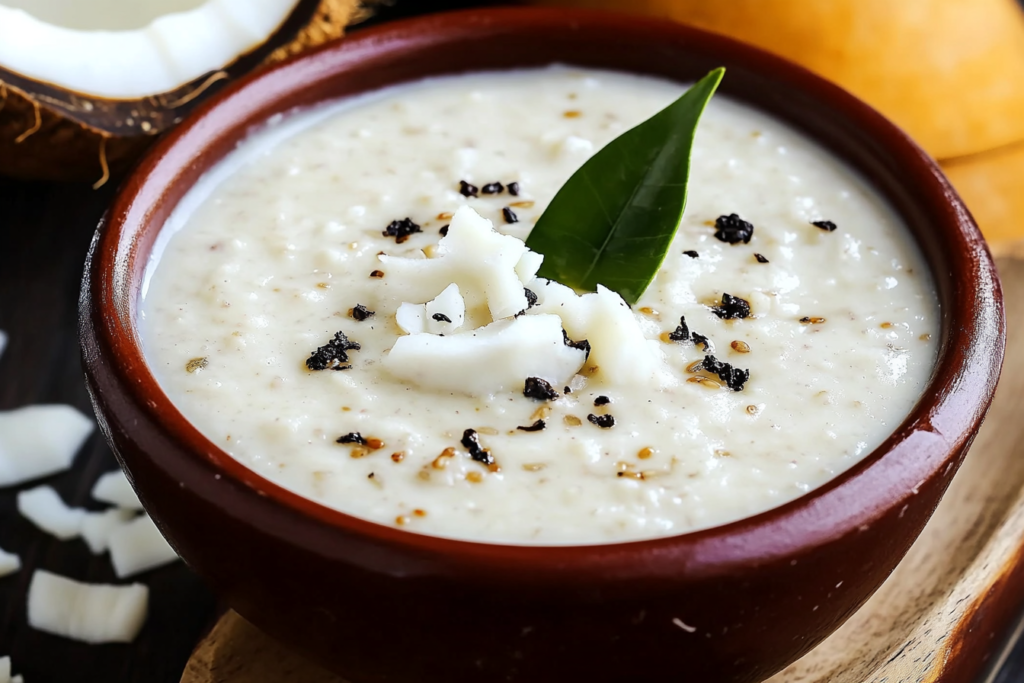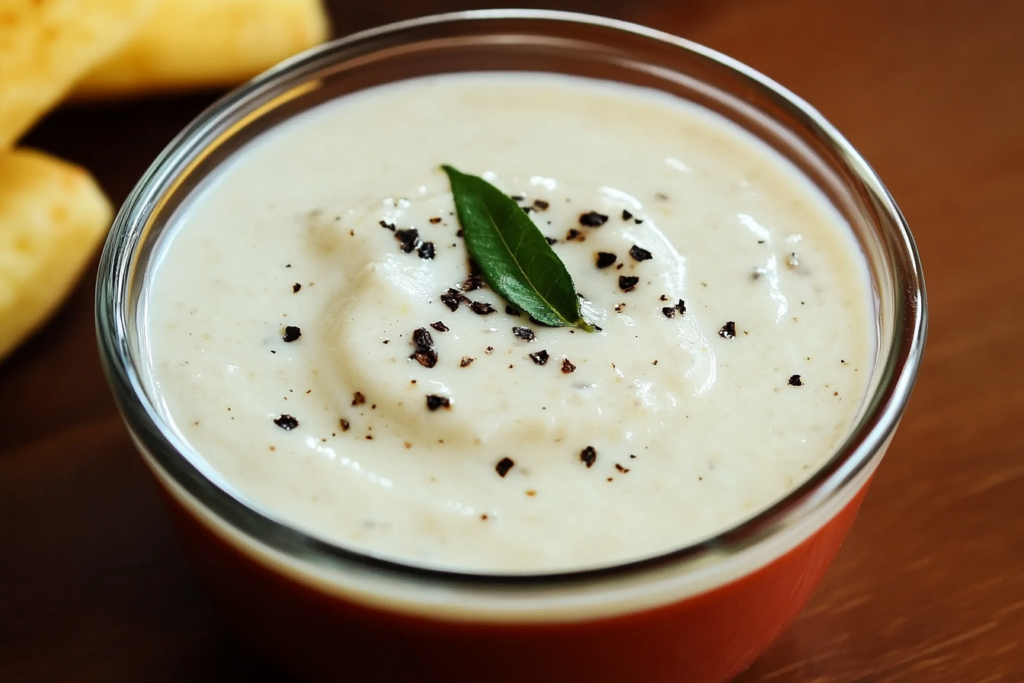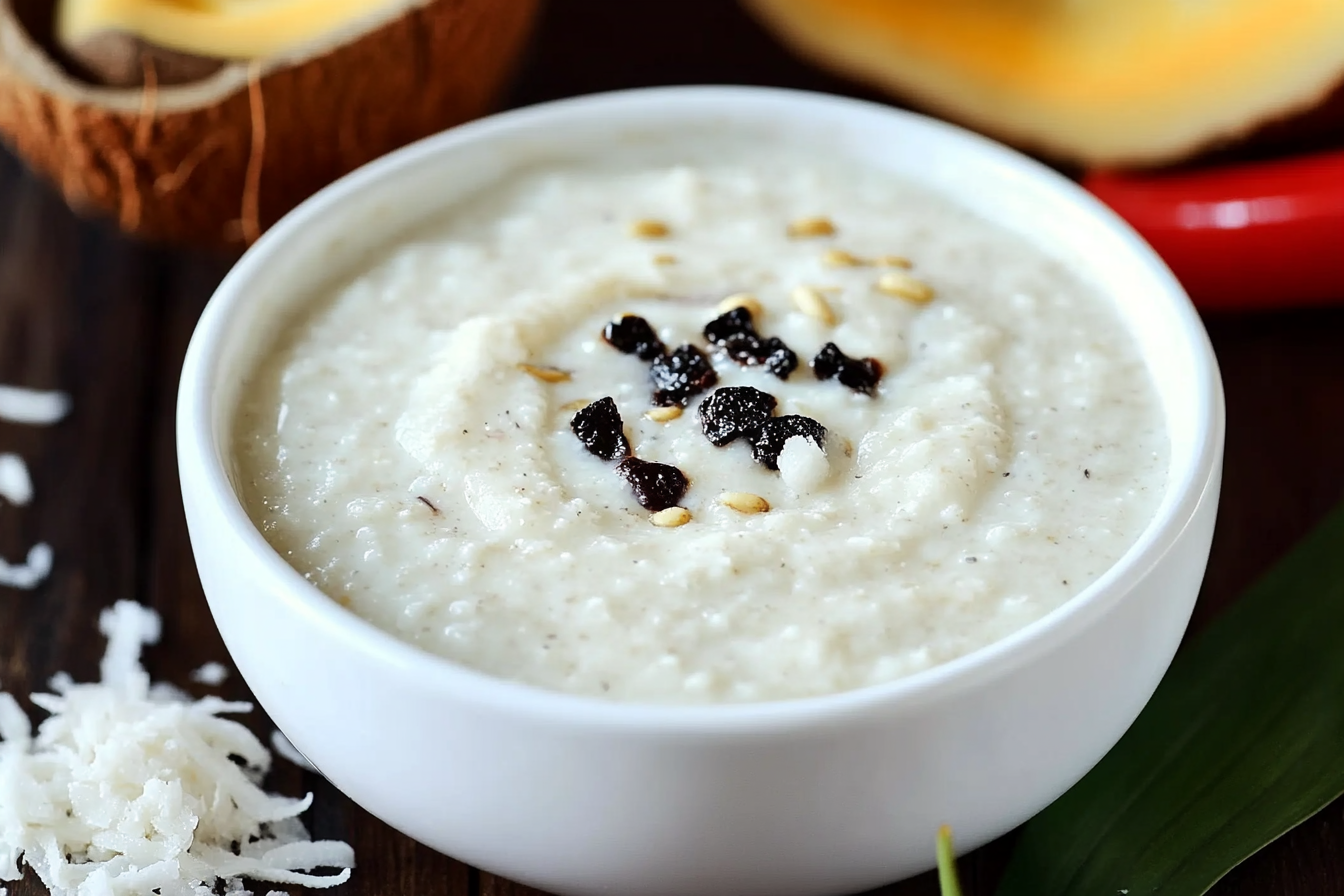Introduction: A Taste of Tradition
Coconut chutney is one of those classic dishes that has the power to transport you straight to the heart of South India with just one bite. Its creamy texture and vibrant mix of spices make it a perfect complement to many traditional Indian dishes. Whether it’s served with crispy dosas, soft idlis, or hot vadas, coconut chutney elevates the entire meal, bringing out the subtle flavors of the main dish while adding its own rich, refreshing taste.
If you’ve ever tasted coconut chutney, you know exactly how it can transform any meal. The combination of fresh coconut, earthy spices, and a bit of tanginess creates a dynamic contrast that your taste buds can’t help but love. In this article, I’ll guide you through the process of making the perfect coconut chutney, including tips, variations, and suggestions on how to serve it. Let’s get started!
Table of Contents
What is Coconut Chutney?
Before diving into the recipe itself, let’s take a moment to understand what coconut chutney is and why it’s so beloved in Indian cuisine.
Coconut chutney is a traditional South Indian condiment made primarily from fresh coconut, with a blend of spices and herbs. It is typically served as a side dish with South Indian breakfast items like dosa, idli, vada, and even pongal. The chutney is known for its smooth, creamy texture and the balance of flavors, from the sweet coconut to the spicy chilies and tangy tamarind.
The beauty of coconut chutney lies in its simplicity. A few fresh ingredients are blended together to create a smooth, flavorful dip that perfectly complements the flavors of other dishes. Over the years, it has become a staple not just in South India, but also in homes around the world where Indian cuisine is loved.
Essential Ingredients for Coconut Chutney
Now that you understand what coconut chutney is, it’s time to gather the ingredients. Fortunately, this recipe doesn’t require too many exotic ingredients, and you may already have most of them in your kitchen. Here’s a list of what you’ll need:
- Fresh Coconut: The star of this dish! Fresh coconut gives coconut chutney its signature smooth and creamy texture. You can find it in most Indian grocery stores or use frozen coconut if fresh is unavailable.
- Green Chilies: These add the perfect amount of heat to the chutney. You can adjust the number of chilies depending on how spicy you prefer your chutney.
- Ginger: A small piece of fresh ginger brings a hint of warmth and depth to the flavor profile.
- Mustard Seeds: Mustard seeds are used for tempering and provide a distinct tangy flavor to the chutney.
- Curry Leaves: These aromatic leaves are a must for authentic South Indian chutneys. They add an earthy, slightly citrusy flavor that enhances the overall taste.
- Tamarind Paste: A small amount of tamarind paste or fresh tamarind gives the chutney a tangy kick, balancing the richness of the coconut.
- Salt: To enhance the flavors and bring everything together.
Ingredients Table
| Ingredient | Quantity |
|---|---|
| Fresh Coconut | 1 cup |
| Green Chilies | 2-3 |
| Ginger | 1-inch piece |
| Mustard Seeds | 1 tsp |
| Curry Leaves | 6-8 leaves |
| Tamarind Paste | 1 tsp |
| Salt | To taste |
Step-by-Step Guide to Making Coconut Chutney

Making coconut chutney is easy and requires very little time. It’s a great addition to your meals that can be prepared quickly with minimal effort. Here’s a simple step-by-step guide to help you make the perfect coconut chutney:
1. Prepare the Ingredients
The first step is to prepare your ingredients. Grate the fresh coconut if it’s not already grated. Freshly grated coconut works best, as it has a softer texture than dried coconut. If you’re using frozen coconut, make sure it’s thawed before using it in the recipe.
Chop the green chilies and ginger into smaller pieces to make it easier to blend. Having everything ready will make the process much smoother.
2. Blend the Coconut, Chilies, and Ginger
Once everything is ready, it’s time to blend. In a blender, combine the grated coconut, green chilies, ginger, and tamarind paste. Add a small amount of water to facilitate blending. Adjust the water based on your desired consistency—use less for a thicker chutney and more for a thinner one.
Blend everything until you achieve a smooth, creamy consistency. Taste the chutney and adjust the spice levels or tanginess if necessary. If you prefer a spicier chutney, you can add an extra green chili.
3. Temper the Chutney
Now comes the tempering step, which is a key part of making coconut chutney. Heat a small amount of oil in a pan over medium heat. When the oil is hot, add the mustard seeds and let them splutter. This process helps release their aromatic flavor into the oil.
Add the curry leaves to the pan and let them fry for a few seconds. The curry leaves will add a fragrant, slightly bitter note to the chutney that is essential for authentic flavor.
4. Combine the Tempering with the Chutney
Once the mustard seeds have spluttered and the curry leaves are fragrant, pour the tempering mixture over the blended coconut chutney. Stir everything together, ensuring the chutney is well-mixed with the spices. Your chutney is now ready to serve!
5. Adjust the Salt and Serve
Before serving, taste the chutney one last time and adjust the salt according to your preferences. Coconut chutney is often served chilled or at room temperature, but you can also enjoy it warm if you prefer.
Tips for the Perfect Coconut Chutney

While the basic recipe is simple, there are a few tips and tricks to ensure that your coconut chutney turns out perfectly every time:
- Use Fresh Coconut: For the best texture and flavor, always opt for fresh coconut. If you use dried coconut, soak it in warm water for a few minutes before using it in the recipe.
- Adjust Spice Levels: You can adjust the heat level by increasing or decreasing the number of green chilies used in the chutney. If you prefer a milder chutney, start with one chili and taste as you go.
- Blend for Smoothness: The smoother your chutney, the better it will complement dishes like dosa and idli. Blend thoroughly to achieve a creamy texture, and add water gradually to get the desired consistency.
- Make it Ahead: Coconut chutney can be made ahead of time and stored in the refrigerator for up to 2-3 days. It will taste even better as the flavors meld together.
With these tips, you can make a coconut chutney that’s full of flavor and pairs perfectly with any South Indian dish!
Variations of Coconut Chutney: Elevating the Flavor
Coconut chutney is a versatile dish that can be easily customized to suit your tastes or to complement different types of meals. While the traditional version made with fresh coconut, green chilies, ginger, and tamarind is delicious on its own, there are many exciting variations you can try. Each variation adds its own unique flavor, making coconut chutney a dish you’ll never get tired of.
1. Coriander Coconut Chutney: A Fresh Twist
One popular variation of coconut chutney is coriander coconut chutney. In this version, fresh coriander (cilantro) is added to the traditional ingredients to bring a burst of freshness. The addition of coriander gives the chutney a bright green color and a vibrant flavor that pairs perfectly with dosas, idlis, and vadas.
To make coriander coconut chutney, simply blend fresh coriander leaves along with coconut, green chilies, ginger, and tamarind paste. You can also add a little lemon juice to give it an extra tang. The refreshing flavor of coriander complements the creamy coconut, making it a delightful addition to any meal.
You can find an excellent coriander coconut chutney recipe on Indian Healthy Recipes, which offers a detailed step-by-step guide and tips to make this variation at home.
2. Peanut Coconut Chutney: A Nutty Delight
If you’re a fan of nuts, then peanut coconut chutney is the variation for you. This chutney combines the creamy coconut with roasted peanuts, adding a nutty richness that is both satisfying and flavorful. The peanuts also give the chutney a slightly thicker texture, making it perfect as a spread for sandwiches or as a dipping sauce for snacks.
To make peanut coconut chutney, roast a handful of peanuts and blend them along with the coconut, green chilies, ginger, and tamarind. The roasted peanuts provide an earthy depth to the chutney, balancing out the sweetness of the coconut. You can adjust the spice level according to your preference, and for a more robust flavor, try adding a pinch of roasted cumin powder.
3. Tomato Coconut Chutney: A Tangy Fusion
Another variation that adds a bit of tang and depth to your chutney is tomato coconut chutney. The sweetness of coconut pairs beautifully with the acidity of tomatoes, creating a chutney with a vibrant and lively flavor profile. This version is especially great for adding an extra layer of complexity to your meals.
To make tomato coconut chutney, cook chopped tomatoes with mustard seeds, curry leaves, and green chilies. Once the tomatoes are soft, blend them along with the coconut, tamarind paste, and ginger. The cooked tomatoes bring out a rich umami flavor, which combines beautifully with the creamy coconut base. This chutney is excellent with rice dishes, idli, or even as a topping for grilled meats.
4. Garlic Coconut Chutney: A Bold Flavor
If you love the bold, savory taste of garlic, this garlic coconut chutney is for you. The raw garlic adds a sharp, zesty flavor that pairs wonderfully with the mild coconut. It’s a great choice if you want a chutney that makes a statement.
To make garlic coconut chutney, sauté some garlic in oil until golden and fragrant, then blend it with fresh coconut, green chilies, ginger, and tamarind. You can also add a bit of jaggery (or sugar) to balance the heat and create a sweet-savory combo that will tantalize your taste buds.
Nutritional Benefits of Coconut Chutney

Coconut chutney is not only delicious but also offers a variety of health benefits due to its simple and nutritious ingredients. Here’s a quick look at the nutritional benefits of some key ingredients in coconut chutney:
- Coconut: Rich in fiber, vitamins, and minerals, coconut is known for its healthy fats, particularly medium-chain triglycerides (MCTs), which are beneficial for heart health and metabolism. It also supports digestive health and can improve skin and hair health due to its high antioxidant content.
- Green Chilies: Green chilies are packed with vitamin C, which boosts immunity and promotes healthy skin. They also contain capsaicin, which has anti-inflammatory properties and can help improve circulation.
- Ginger: Ginger is known for its anti-inflammatory and digestive benefits. It helps relieve nausea, reduce muscle pain, and support immune function. It also promotes healthy digestion, which is great for overall wellness.
- Curry Leaves: Rich in antioxidants, curry leaves are beneficial for skin health and have been traditionally used to manage cholesterol levels and blood sugar levels.
- Tamarind: Tamarind adds a tangy flavor to the chutney and is rich in antioxidants, helping to fight free radicals in the body. It also aids in digestion and provides a good source of iron.
By incorporating coconut chutney into your meals, you can enjoy both its amazing taste and its numerous health benefits. It’s a simple yet powerful way to enhance your nutrition while indulging in something flavorful.
How to Serve Coconut Chutney
Coconut chutney pairs beautifully with a wide variety of dishes, making it a versatile condiment that can elevate any meal. Here are some popular ways to serve coconut chutney:
1. With Dosa: The classic pairing! Serve coconut chutney alongside crispy dosas for a perfect breakfast or snack. The chutney’s creamy texture balances the crispy exterior of the dosa, making each bite a delightful experience.
2. With Idli: Soft, fluffy idlis dipped in coconut chutney are a comforting combination. The mild flavors of the idli pair wonderfully with the rich, spicy chutney, making it a traditional breakfast favorite.
3. With Vada: Vadas are deep-fried fritters that are perfect for dunking into coconut chutney. The chutney’s refreshing taste helps cut through the richness of the vada, creating a harmonious balance of flavors.
4. As a Spread: Coconut chutney also works as a flavorful spread for sandwiches, wraps, or even as a topping for grilled meats. It adds a burst of freshness and flavor, turning any ordinary dish into something special.
Related Recipes You Might Enjoy
If you love coconut chutney, you might also enjoy exploring other recipes that pair wonderfully with it. One such recipe is Gnocchi Carbonara, which is creamy and comforting, yet offers a slightly smoky flavor. You can find the recipe for The Ultimate Gnocchi Carbonara on My Recipes Era. It’s the perfect Italian-inspired dish to serve with a side of coconut chutney for an exciting fusion meal.
Conclusion: Coconut Chutney – A Simple, Yet Flavorful Delight
Coconut chutney is a classic South Indian condiment that can easily be made at home with a few basic ingredients. Its versatility allows you to experiment with different variations, from coriander to peanut and tomato chutney, each offering its own unique twist. Whether served with traditional dishes like dosa and idli or used as a spread, coconut chutney adds a refreshing and flavorful touch to any meal.
Try making your own coconut chutney today, and explore the many ways this delicious dish can enhance your meals. Don’t forget to experiment with different variations, and most importantly, enjoy the process of creating something homemade and delicious.
FAQs About Coconut Chutney
1. What can I use instead of tamarind in coconut chutney?
If you don’t have tamarind on hand, you can substitute it with a bit of lemon juice or vinegar for a tangy flavor. Some people also use a small amount of pomegranate seeds for a slightly sweet and sour touch. If you’re looking for a milder option, a bit of yogurt can add creaminess and tang.
2. How long can I store coconut chutney?
Coconut chutney is best when served fresh, but it can be stored in an airtight container in the refrigerator for up to 2-3 days. For longer storage, you can freeze it for up to a month. Simply thaw it before serving and give it a good stir. Keep in mind that the texture may change slightly after freezing.
3. Can I make coconut chutney without a blender?
While a blender is the most common tool used for making coconut chutney, you can also use a mortar and pestle to grind the ingredients. This will give the chutney a more rustic texture. It will take a bit more effort, but the result will still be delicious and flavorful.
4. Is coconut chutney spicy?
Coconut chutney can be made as spicy or mild as you like. The traditional recipe includes green chilies, which add heat. If you prefer a milder chutney, you can reduce the amount of chilies or remove the seeds to cut down on the spice level. Alternatively, if you love heat, you can add extra chilies or even experiment with different types, such as red chilies or dried chili flakes.
5. Can coconut chutney be used for anything other than South Indian dishes?
Absolutely! While coconut chutney is commonly paired with South Indian dishes like dosa and idli, it also works well as a dip for snacks, a spread for sandwiches, or a topping for grilled meats. You can get creative and use it to elevate almost any meal!

